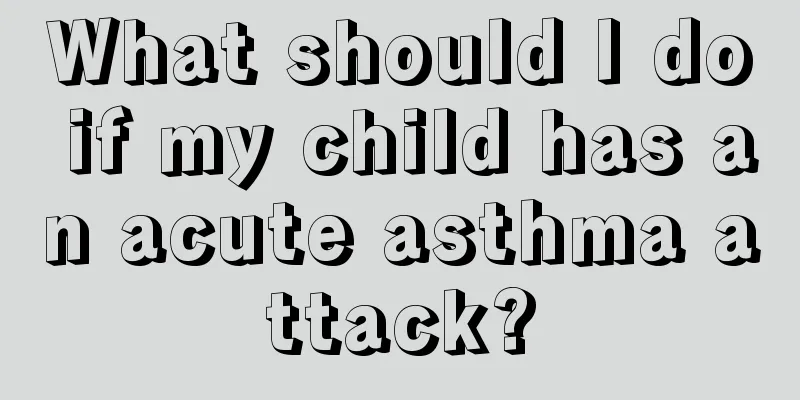Respiratory syncytial virus positive

|
Respiratory syncytial virus mostly occurs in newborns, and the incubation period is generally three to seven days. Infants with this disease have more severe symptoms, mainly because the baby's immune function is not fully developed, so they are very susceptible to viral infection. Common symptoms include high fever, pharyngitis, rhinitis and other respiratory infections. This disease is mainly caused by air droplets or close contact, so is a positive respiratory syncytial virus test serious? Basic Introduction Respiratory syncytial virus pneumonia (RSV pneumonia), referred to as RSV pneumonia, is a common interstitial pneumonia in children, mostly occurring in infants and young children. Since maternal antibodies cannot prevent infection, newborns may become ill, but it is less common in newborns. There are occasional reports of nosocomial infections causing epidemic outbreaks in neonatal wards of obstetric hospitals abroad. Medical measures diagnosis In the past decade, syncytial virus pneumonia and bronchiolitis have ranked first among viral pneumonias in infants and young children in my country. Their symptoms are clinically almost indistinguishable from parainfluenza virus pneumonia, mild influenza virus pneumonia, and mild adenovirus pneumonia. Severe influenza virus pneumonia and severe adenovirus pneumonia are characterized by persistent high fever, severe poisoning and respiratory symptoms, and the clinical manifestations are far more severe than those of syncytial virus pneumonia. The diagnosis of this disease is mainly based on the results of virological and serological tests. In recent years, indirect immunofluorescence technology using exfoliated cells of nasopharyngeal secretions and IgM antibodies in serum, ELISA, alkaline phosphatase-anti-alkaline phosphatase bridged enzyme label assay (APAAP), biotin-anti-biotin ELISA, horseradish peroxidase-anti-horseradish peroxidase (PAP), monoclonal antibody fluorescence method, etc. can be used for rapid diagnosis of syncytial virus infection. Clinical manifestations This disease is more common in infants and young children, more than half of whom are infants under 1 year old. There are more boys than girls, with a ratio of about 1.5 to 2:1. The incubation period is about 4 to 5 days. Cough and nasal congestion may be seen in the early stages. About 2/3 of the cases have high fever, which can reach up to 41°C, but the fever is generally not persistent and is easily reduced by antipyretics. The high fever lasts mostly for 1 to 4 days, and a few for 5 to 8 days. About 1/3 of the children have moderate fever, which usually lasts 1 to 4 days. In most cases, the fever lasts for 4 to 10 days. Mild cases have no obvious dyspnea and neurological symptoms, while moderate and severe cases have obvious dyspnea, wheezing, cyanosis of lips, scalloped nose and three-recess sign. A few severe cases may also be complicated by heart failure. Chest auscultation usually produces fine, coarse or medium rales, and percussion usually produces no dull sounds, although a few may produce clear sounds. X-ray examination: Most cases have small flake-like shadows, large flake-like shadows are extremely rare. About 1/3 of the children have varying degrees of emphysema. Blood picture: The total white blood cell count is generally between (5-15)×109/L (5000-15000/mm3), and most are below 10×109/L (10000/mm3). The neutrophil count is usually below 70%. Treatment Pay special attention to general treatment, pay attention to isolation, and try to prevent secondary bacterial or other viral infections. If there is no secondary bacterial infection, only traditional Chinese medicine treatment is needed. For general treatment, please refer to the section on bronchopneumonia, and for others, please refer to the section on adenovirus pneumonia. Since the disease is relatively mild, there is no need for so much symptomatic and supportive therapy. Regarding antiviral chemical drugs, more serious cases can be treated with triazole ribavirin nebulization. Please refer to the previous volume for an overview of viral infectious diseases. Recently, some people abroad have used short-term, high-dose nebulization to effectively treat syncytial virus infection. In addition, in recent years, Shanghai Xinhua Hospital has used whey liquid (colostrum dilution) nebulization to treat syncytial virus lower respiratory tract infections, and Wenzhou Medical College has extracted SIgA from colostrum for nebulization inhalation to treat respiratory syncytial virus pneumonia, which has achieved good results and can be applied. Prognosis The disease is generally mild. Simple cases recover clinically in 6 to 10 days, and X-ray shadows usually disappear in 2 to 3 weeks. If the isolation measures are not effective, secondary infection is likely to occur and fever may occur again. Death from simple syncytial virus pneumonia is rare. |
<<: Baby's stool test positive for occult blood
>>: 3-year-old child complains of chest pain at night
Recommend
What causes knee pain in children?
Children are the most precious treasures in every...
How to comb your child's hair to look good
If there is a baby girl at home, the mother alway...
What should I do if my three-month-old baby has trouble sleeping?
I believe everyone knows the importance of sleep ...
The harm of picky eating in children
I believe that as parents, we can fully understan...
How to treat children with animal phobia
Some people think small animals are very cute and...
What causes foam in children's urine?
Some children have problems with their urine, so ...
Baby picking nose and nose bleeding
The feeling of having a foreign body in the nose ...
Why does a five-month-old baby cry at night?
Many parents go to work with dark circles under t...
What should I pay attention to if my baby always has eye mucus?
What should you pay attention to if your baby alw...
Why does my child have knee pain at night?
Sometimes I feel knee pain at night, which is par...
Will baby strawberry hemangiomas disappear?
Hemangioma is a common disease in infants. Many p...
How should the baby’s diet be arranged when he has a fever?
For new mothers, once their baby has a fever, the...
Is it OK to bathe your baby every day?
In the hot summer, after sweating profusely, peop...
What to do if children have bone necrosis?
Bone necrosis in children usually refers to the f...
Does Fengyoujing have any effect on babies?
Fengyoujing is often used in our daily life, espe...









